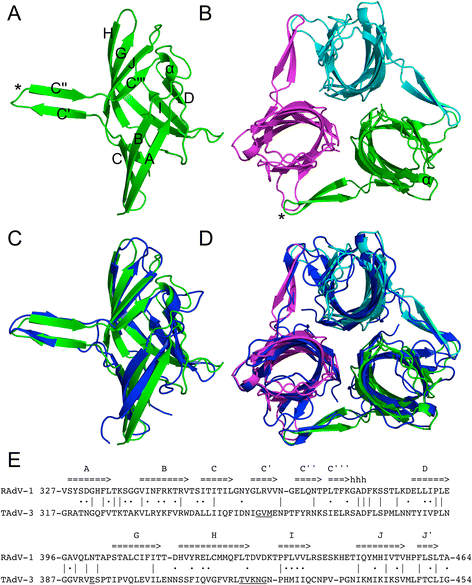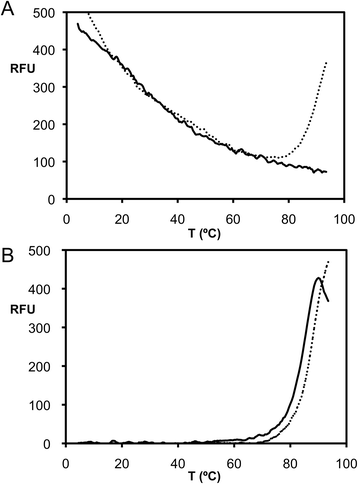Crystal structure of raptor adenovirus 1 fibre head and role of the beta-hairpin in siadenovirus fibre head domains
- PMID: 27334597
- PMCID: PMC4918002
- DOI: 10.1186/s12985-016-0558-7
Crystal structure of raptor adenovirus 1 fibre head and role of the beta-hairpin in siadenovirus fibre head domains
Abstract
Background: Most adenoviruses recognize their host cells via an interaction of their fibre head domains with a primary receptor. The structural framework of adenovirus fibre heads is conserved between the different adenovirus genera for which crystal structures have been determined (Mastadenovirus, Aviadenovirus, Atadenovirus and Siadenovirus), but genus-specific differences have also been observed. The only known siadenovirus fibre head structure, that of turkey adenovirus 3 (TAdV-3), revealed a twisted beta-sandwich resembling the reovirus fibre head architecture more than that of other adenovirus fibre heads, plus a unique beta-hairpin embracing a neighbouring monomer. The TAdV-3 fibre head was shown to bind sialyllactose.
Methods: Raptor adenovirus 1 (RAdV-1) fibre head was expressed, crystallized and its structure was solved and refined at 1.5 Å resolution. The structure could be solved by molecular replacement using the TAdV-3 fibre head structure as a search model, despite them sharing a sequence identity of only 19 %. Versions of both the RAdV-1 and TAdV-3 fibre heads with their beta-hairpin arm deleted were prepared and their stabilities were compared with the non-mutated proteins by a thermal unfolding assay.
Results: The structure of the RAdV-1 fibre head contains the same twisted ABCJ-GHID beta-sandwich and beta-hairpin arm as the TAdV-3 fibre head. However, while the predicted electro-potential surface charge of the TAdV-3 fibre head is mainly positive, the RAdV-1 fibre head shows positively and negatively charged patches and does not appear to bind sialyllactose. Deletion of the beta-hairpin arm does not affect the structure of the raptor adenovirus 1 fibre head and only affects the stability of the RAdV-1 and TAdV-3 fibre heads slightly.
Conclusions: The high-resolution structure of RAdV-1 fibre head is the second known structure of a siadenovirus fibre head domain. The structure shows that the siadenovirus fibre head structure is conserved, but differences in the predicted surface charge suggest that RAdV-1 uses a different natural receptor for cell attachment than TAdV-3. Deletion of the beta-hairpin arm shows little impact on the structure and stability of the siadenovirus fibre heads.
Keywords: Atomic structure; Beta-hairpin; Deletion mutagenesis; Protein stability; Siadenovirus; X-ray crystallography.
Figures




Similar articles
-
Structure and Sialyllactose Binding of the Carboxy-Terminal Head Domain of the Fibre from a Siadenovirus, Turkey Adenovirus 3.PLoS One. 2015 Sep 29;10(9):e0139339. doi: 10.1371/journal.pone.0139339. eCollection 2015. PLoS One. 2015. PMID: 26418008 Free PMC article.
-
Crystal structure of the fibre head domain of bovine adenovirus 4, a ruminant atadenovirus.Virol J. 2015 May 22;12:81. doi: 10.1186/s12985-015-0309-1. Virol J. 2015. PMID: 25994880 Free PMC article.
-
Confirmation of a novel siadenovirus species detected in raptors: partial sequence and phylogenetic analysis.Virus Res. 2009 Mar;140(1-2):64-70. doi: 10.1016/j.virusres.2008.11.005. Epub 2008 Dec 18. Virus Res. 2009. PMID: 19061925
-
Adenoviruses across the animal kingdom: a walk in the zoo.FEBS Lett. 2019 Dec;593(24):3660-3673. doi: 10.1002/1873-3468.13687. Epub 2019 Dec 9. FEBS Lett. 2019. PMID: 31747467 Review.
-
Structural evidence for common functions and ancestry of the reovirus and adenovirus attachment proteins.Rev Med Virol. 2003 Mar-Apr;13(2):123-32. doi: 10.1002/rmv.379. Rev Med Virol. 2003. PMID: 12627395 Free PMC article. Review.
Cited by
-
Adenovirus Structure: What Is New?Int J Mol Sci. 2021 May 15;22(10):5240. doi: 10.3390/ijms22105240. Int J Mol Sci. 2021. PMID: 34063479 Free PMC article. Review.
-
Adenoviruses in Avian Hosts: Recent Discoveries Shed New Light on Adenovirus Diversity and Evolution.Viruses. 2022 Aug 13;14(8):1767. doi: 10.3390/v14081767. Viruses. 2022. PMID: 36016389 Free PMC article.
-
Novel sampling strategies and a coarse-grained score function for docking homomers, flexible heteromers, and oligosaccharides using Rosetta in CAPRI rounds 37-45.Proteins. 2020 Aug;88(8):973-985. doi: 10.1002/prot.25855. Epub 2019 Dec 3. Proteins. 2020. PMID: 31742764 Free PMC article.
References
-
- Wold WS, Horwitz MS. Adenoviruses. In: Fields BN, Knipe DM, Howley PM, editors. Fields virology. 5. Philadelphia: Wolters Kluwer Health/Lippincott Williams & Wilkins; 2007. pp. 2395–436.
-
- Benkő M. Adenoviruses: pathogenesis. In: Reference Module in Biomedical Sciences. Elsevier; 2015. doi:10.1016/B978-0-12-801238-3.02526-5.
-
- Waye MMY, Sing CW. Anti-viral drugs for human adenoviruses. Pharmaceuticals (Basel) 2010;3(10):3343–54. doi: 10.3390/ph3103343. - DOI
-
- Pihos AM. Epidemic keratoconjunctivitis: a review of current concepts in management. J Optom. 2013;6(2):69–74. doi: 10.1016/j.optom.2012.08.003. - DOI
Publication types
MeSH terms
Substances
LinkOut - more resources
Full Text Sources
Other Literature Sources

